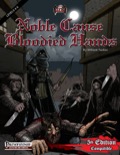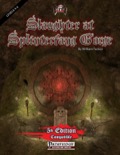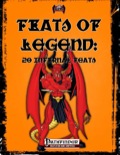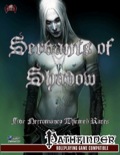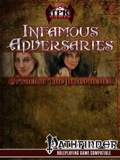Sign in to create or edit a product review. I finally had a chance to run this module for my brother and sister in law while we were camping. We had an absolute blast. The maps were simple enough that I could quickly sketch them out on a bit of paper but with enough complexity and blind corners and such that I could have their enemies really work their thieves guild theme. Kudos especially go to the neat traps in this module. The party was lucky that they had a rogue this time! As the DM (especially one working from his phone and having ZERO preparation), I appreciated the writing with solid descriptions of rooms and good details offered for major NPCs. Without giving too much away, I think the scene towards the beginning in the market with the banner might have been our favorite moment in the module. It was a great idea and I think the trap and ambush there really set the tone for the adventure. This is a solid adventure with no ethically challenging bits, nothing to stop you from going full murder-hobo. The bad guys here makes no bones about being bad. Or well, they do make bones but they are tiny elven infant bones and that rather reinforces the whole bag guy thing. Despite the fact that it's a pretty straightforward good guys have to stop bad guys thing, the story is actually pretty rich with the weight of a history between bugbears and elves behind it. The bad guys, especially the high damage dealing bugbears are pretty nasty. True to the moniker, I think there's a real possibility for some TPKs. My only issue is a bit of a lack of diversity. The PCs will fight Goblins, Goblin Marauders, Goblin Archers, and Goblin Dogs with a lot of frequency. Worgs, too. Each bugbear captain is different and there are a few other beasties and traps but it's mostly hunting down little greenskins. It's forgivable since it's a goblinoid themed adventure but I could still wish for some additional types of goblins that could employ different tactics or maybe some caged and enraged monster they could point at the PCs. Full stat blocks and other necessary information is available to run this game in Pathfinder or 5e and I didn't notice any obvious errors due to the translation between systems. This book, as the name states, includes twenty new feats for anyone interested in being diabolical (in the truest sense of that word). Things I liked:
For two bucks this is a great buy. This book can be utilized by more than just evil characters; make a character cursed by devilish forces or who made a pact with devils to hunt demons. So many great ideas that can be fleshed out by these feats. Massing a huge 162 pages, Laying Waste is an enormous revamp of rules for critical hits in Pathfinder. The books starts with the new rules which essentially replace the confirmation roll and normal, boring damage multiplication with a severity roll and a host of potential effects based on the severity and damage type of your weapon. All the possible crits have a save to reduce or eliminate the status effect. The save gets harder as your severity worsens as does, obviously, the effect. A light braining staggers for d2 rounds unless you make a DC20 Fortitude save. A moderate braining is staggered for d3 rounds and the severe version deals additional damage along with d3 rounds of the staggered condition. In each case, the DC gets harder by 5 as well. Even if your victim...er...target passes the save associated with the crit, they are still saddled with some bonus damage. The bonus damage varies from 2d6 with a x2 crit to 5d6 on a x5 weapon. This is a nice system that means a dagger to your kidney (or whatever strange organ drives your renal system) hurts just about as bad as a greatsword, which, while not necessarily going to make a simulationist happy, makes those that love variety in weapons ecstatic. Status effects caused by crits have conditions under which they can be healed. Rest or curative magic are generally there but in most cases you can also make a Heal check. Heal. It’s a skill. It’s between Handle Animal and Intimidate on your character sheet. You can be forgiven for not knowing it’s there; until now there hasn’t usually much reason to take it. I’m so pleased that this undervalued skill gets a real reason to exist in this ruleset. After pages and pages of bashing, slicing, dicing, and otherwise mauling with criticals, comes ten or so pages of critical themed feats. There’s a lot of good stuff here like Sneaking Strike which causes opponents who take a crit from a rogue to become flat-footed until the end of the rogue’s next turn, a great way to get more sneak attacks in. There are achievement feats and mythic feats to be had here and a lot of neat things to do with combat maneuvers. Then we have the archetypes. This is where I suffer from some disappointment. As the focus of this book is on critical hits, I can kind of understand why there aren’t archetypes for the sorcerer and wizard (although it seems like one that changed elemental damage into a physical damage type and did something with these rules is an easy fit) but not having a single archetype for the paladin, cleric, bard, druid, or any of the base classes means this whole section has limited value for me. What’s there is cool and chock full of flavor, though. The pressure point master is inspired and the scoundrel, mockingbird, disembowler, and urchin knight are great, too. Next are the rules for fumbles, separated into melee, ranged, and natural attack fumbles. I’m a huge fan of these. In my group, some fights are just done by story and the dice are left to rest for a time. Inevitably, my players mix failure into their success and get thrown across a room, trip on a rug (which otherwise tied the room together), or simply stare dumbfounded at the unfolding horror of an elder god before the tentacular alarm clock wakes them up. But this never happens when we roll the dice. Misses are set aside and damage from the hits tabulated. The fumble rules give us the opportunity to force these situations into the dice rolling and enhance our stories. If I were an alchemist I’d take the vestigial arm discovery just to give this three thumbs up. The remaining 30 or so pages are given over to appendices covering rules for called shots, armor as damage reduction, healing and scars, spells, magic weapon and armor abilities, a short bit of prose and a Laying Waste Iconic NPC. I give this book 4.5 out of 5. The rules are pretty great. The fact that there’s an Android app for Laying Waste crits is great. the lack of variety in the archetypes section is an absolute travesty (figuratively speaking; literally speaking it’s more of a bummer). Personally, I don't much like undead races. I wouldn't play one. I tell you this because despite that, I still really liked this book. First, we have the Mortiss, undead creatures escaped from the afterlife to get a second chance among mortals. Basically a sentient zombie, with all the ripe smells that accompny such a character you'll be sure to be a real treat during mealtimes. There's a genuinely awesome magus archetype for the race and a mortiss paragon prestige class. Next up is the Forsworn, so called because they've given up their mortal soul in return for immortality. It's an acquired template instead of an actual race and I can certainly see a necromancer in your game seeking the rites to be able to do this to themselves. They have a witch archetype (a watered down 3.5 warlock), a paragon prestige class, and some really neat racial feats that allow you to graft bones onto undead as armor among other things. Third in the book and definitely the most gross is the Maghra. Once upon a time they were just jerks. Then they ate a bunch of ghouls and became undead jerks that eat people. If you've ever want to get a bonus for eating your fallen enemies, I have a solution for you. Also the phone number for a mental health professional. They have a racial paragon PrC and a bunch of feats to augment the bonuses you get for eating someone. Not content to just eat the flesh, you can also use feats to get a bonus for eating the skin or the bones. Because at that point, why not? Moving on, the Deathless are quite interesting. Another applied template, sometimes a god of death or necromancy needs some boots on the ground to take some petty vengeance or hunt down escaped souls. A sidebar suggests the template as a way to bring a fallen PC back to the party. If you want to do this, be aware that this template has a +2 level adjustment so you might need to break it down into two levels of abilities that they can get as though multiclassing or dropping two levels of their previous class. Deathless also have a racial paragon PrC and some racial feats. Finally, the nephandim are gnome-like little stewards of the underworld with control over hellfire and significant bonuses to necromantic spellcasting. They have a cleric archetype and, like the rest, a racial paragon PrC. The book is liberally spotted with new necromancy spells, there's a new template for bonescriven undead, and a profile for Nergal, TPK's god of the dead. A number of these races have really fascinating moral dilemmas built in for players to explore and TPK helpfully points them out. What does a person do when they're undead but yearn for life? Consumed with unnatural urges that must be controlled to fit into society among the living? These races lack the glitz and glamour of vampires. With the exception of the forsworn, it would be difficult to pass yourself off as normal playing one of these races. While that can create some problems at the table, I think it's outweighed by how this might turn even the most mundane conversations in interesting directions. As a GM, if you have players interested in these races be sure to have a conversation about expectations. Undead have a lot of immunities. While they're probably going to be harder to heal for a traditional cleric, they're also going to shrug off most spells that require fort saves and a number of conditions. It's not impossible to do. I have a player right now who's doing it just fine. It just really needs open lines of communication so that everything works out for everyone at the table. This is an excellent supplement for GMs and players alike. Nearly 60 pages of content with some great art (the phenomenal cover included) there a lot here for everyone. The first seven pages feature some really great advice for adding more personality to your monsters to make encounters more interesting. I think there's some good stuff here. As GMs, we often forget that every intelligent creature, not just the big bad guys, that the players face has lived their life and had experiences and has a personality. It's all too easy to just make them just boring slogs. Giving monsters occasional phobias or other forms of madness, angry or even happy (to have their dinner delivered) adds spice to your encounters. Next we have some dragon specific goodies like rules for draconic barding, embedding treasure in their scales, and a few pages of feats. I really liked the rules for embedding treasure in scales, especially the mechanic that calls for it to drop off bit by bit while the dragon flies leaving a trail. What a great hook. If any of my players are reading this, follow the trail of gold and gems. Nothing bad will happen to you. I promise. Lastly, come the bloodline feats. Until now, pretty much the only way to make your character born from draconic ancestry was to play a sorcerer. No longer. With Major Bloodline feats you can take at first level or traits that give you more limited access you can be part of a proud (or shameful) dragon lineage. Now you have access to a wealth of feats letting you grow wings or a tail, walk on clouds, get a breath weapon or spell-like abilities, or even more awesome stuff. There's a lot of potential for awesomeness here which always means potential for abuse so players and GMs should communicate about when is appropriate to introduce things like flight. Let's be honest, GM's are the true heroes of our games. What our GMs prepare all week for, we blow through in a couple hours with our PCs. It's hard work but luckily, TPK Games is here to help! The book contains Cytheria's Stat Block, complete with helpful links to d20PFSRD for quick reference. It also contains tactics, the stat block for her fiendish servant, a great backstory for her and her organization and two plot hooks to work her into your game. The art is also top notch. Cytheria is great for your home brew campaign or even an AP. She'd fit in very well in Curse of the Crimson Throne or Carrion Crown, especially. Like the Magus but feel pinned by the damnable "one hand free whenever you want to do something cool" restriction? This book has solutions! By allowing you to invest your Arcana and Arcane Pool Points into three different trees, you can fight with two weapons, a 2-hander, or a shield. That's exciting just by itself. But there's more! Lots of really awesome Arcana to let you use your Pool Points to mimic spells or get a skill bonus. The archetypes are really interesting, too. With the slew of new Arcana, the Arcana Lord is a really attractive option. Arcana Lords sacrifice the spell casting versatility of the Magus for more Arcana and the ability to burn spells for more Pool Points. The Cabalist shares a casting progression and spontaneous casting with the Bard and get access to a Sorcerer bloodline. The Magavan replaces spell strike with a crazy but interesting knowledge ability. Learning via stabbing. Sounds like public schools =) The Tovenaar is the only one I'm kind of not excited about. Instead of spellcasting this archetype gets access to Inquisitions from Ultimate Magic. I'm just not sure there are inquisitions good enough for me to possibly lose casting. But I guess if someone is adamantly opposed to casting, this is a good way to use the Magus. All in all a great little resource for only $3. 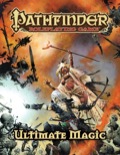
Pathfinder Roleplaying Game: Ultimate Magic (OGL)Paizo Inc.Hardcover Unavailable Add PDF $19.99
Add
Non-Mint
Only good enough for the PDFChapter 1: Spellcasters The first chapter is also the best. The Magus is nice and there are several very interesting archetypes here. I wish the Ranger had got a bit more of a generous treatment as I think the game could benefit from a class midway between Druid and Ranger but I'll live. If the whole book was of this quality, this book would get 5 stars easily. Chapter 2: Mastering Magic But, alas, the whole book is not of the same quality. This chapter is almost entirely horrible. The last section, designing spells, is phenomenal and much needed. Everything else is so very niche that feel like it deserved its own book, a book for people that need to bind outsiders, create and control constructs, and spell duel. Plus, seven pages devoted to premade spell books. How do you combine such advanced stuff and such beginners stuff into one chapter? Chapter 3: Feats Pretty good chapter. Paizo took an interesting tack here and made nearly all the feats in here related to class features. There are ways to improve Lay on Hands, Stern Gaze, Familiars, Eidolons, Bloodlines, Hexes and everything else. It's pretty neat. Seems a sort of logical continuation of the archetypes, allowing focus on certain aspects of a character. Chapter 4: Words Hrm. I'm not a huge fan of the system. It feels clunky and I'm not sure I could see myself using it, especially when there's a pretty good section on creating/researching new spells. Chapter 5: Spells A distressing mix of really niche stuff and really bad stuff with a few gems in there. Some of the stuff is wonderfully flavorful like Arboreal Hammer. Some of the stuff is just terrible like Cold Ice Strike. Cold Ice Strike is just a quickened Cone of Cold but only one level higher. Does it have an expensive material component to make up for this unbalanced blasphemy? No one knows because they forgot to include the component line. And there a number of other spells missing that line, too. That's some really basic information to not include. And then there are spells like Blood Crow Strike and Steal Ki which seem to only exist for the Qinggong Monk. I was hoping for a bit more variety in the touch spell department, especially in the book in which the Magus was introduced. I was also hoping for a bit more offensive goodies for the Cleric/Oracle but was mostly disappointed. |





